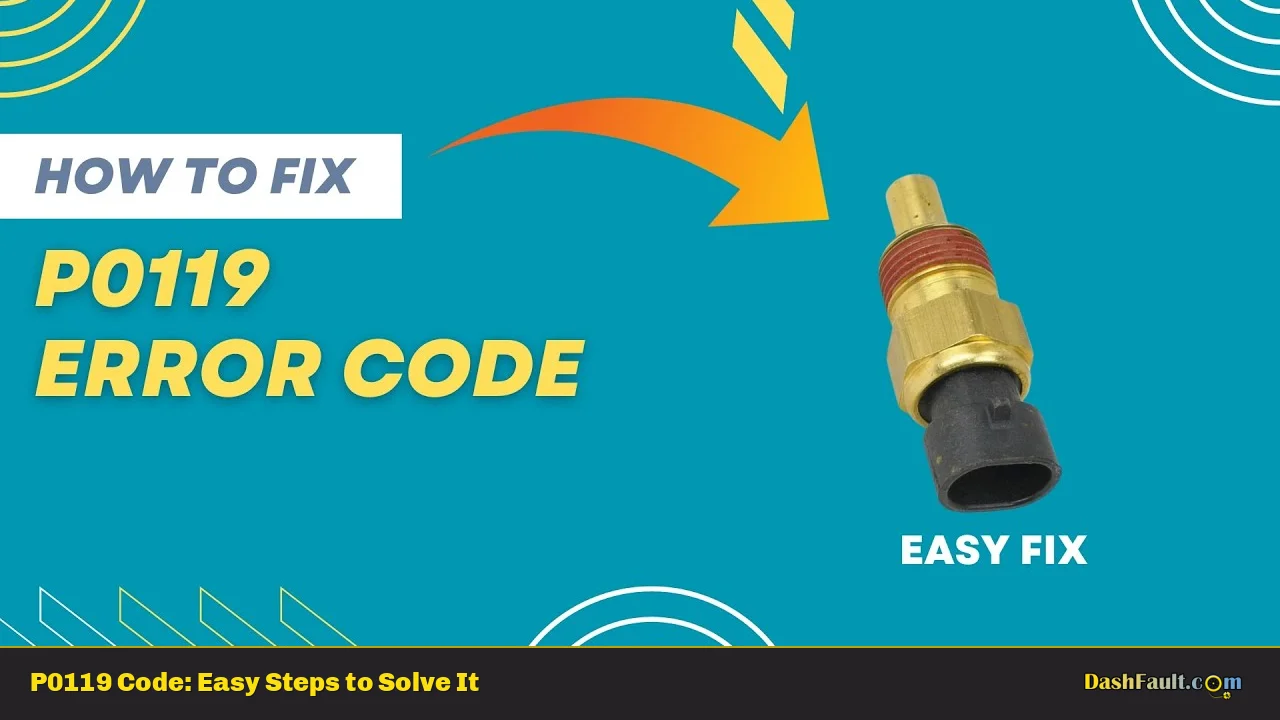The P0119 trouble code refers to an issue with the Engine Coolant Temperature (ECT) Sensor Circuit, specifically indicating that the sensor is providing an intermittent or erratic signal to the Engine Control Module (ECM). This code is part of the On-Board Diagnostics II (OBD-II) system and can affect various vehicle makes and models manufactured after 1996. Understanding this code is crucial for vehicle owners and DIY mechanics, as it can lead to significant engine performance issues if not addressed promptly.
| P0119 Code Meaning | P0119 Code Common Causes |
|---|---|
| Engine Coolant Temperature Sensor Circuit Intermittent | Faulty Engine Coolant Temperature Sensor |
| Intermittent Signal to the ECM | Wiring Issues (open or shorted) |
| Erratic Temperature Readings | Low Coolant Level |
| Malfunctioning Thermostat | |
| Corroded Connectors |
Symptoms of P0119 Code
When the P0119 code is triggered, several symptoms may manifest, indicating that there is a problem with the engine coolant temperature sensor or its circuit:
- Check Engine Light: The most common symptom is the illumination of the check engine light on the dashboard.
- Engine Performance Issues: Drivers may experience irregular idling, decreased power during acceleration, or difficulty starting the engine.
- Inconsistent Temperature Readings: The temperature gauge may fluctuate or display erratic readings, leading to confusion regarding the actual engine temperature.
- Poor Fuel Efficiency: Incorrect readings from the ECT sensor can lead to improper fuel mixture adjustments, resulting in reduced fuel economy.
Technical Explanations
The ECT sensor plays a vital role in a vehicle’s engine management system by measuring the temperature of the engine coolant. This information is crucial for optimizing fuel injection timing, ignition timing, and overall engine performance. When the ECM detects an intermittent signal from this sensor, it triggers the P0119 code.
The potential causes for this issue include:
- Faulty ECT Sensor: The sensor itself may be damaged or malfunctioning, leading to inaccurate readings.
- Wiring Issues: Damaged or corroded wiring and connectors can disrupt the signal sent from the ECT sensor to the ECM.
- Low Coolant Level: Insufficient coolant can cause overheating and affect sensor performance.
- Malfunctioning Thermostat: A thermostat that does not open or close properly can also contribute to erratic temperature readings.
Step-by-Step Diagnosis
Diagnosing a P0119 code involves several steps:
- Use an OBD-II Scanner: Start by connecting an OBD-II scanner to retrieve the trouble code. Confirm that it is indeed P0119.
- Visual Inspection: Inspect the ECT sensor for dirt or debris. Check wiring and connectors for any signs of damage or corrosion.
- Check Coolant Level: Ensure that the coolant level is adequate and that there are no leaks in the cooling system.
- Test ECT Sensor: Using a multimeter, measure the resistance of the ECT sensor at various temperatures to ensure it operates within specifications.
- Monitor Performance: Use advanced diagnostic tools to monitor real-time data from the ECT sensor while driving under different conditions.
Solution Methods
Once diagnosed, here are recommended solutions:
- Replace Faulty ECT Sensor: If testing reveals that the ECT sensor is defective, replace it with a new one. The cost typically ranges from $50-$150 USD depending on vehicle make and model.
- Repair Wiring Issues: If damaged wiring or connectors are found, repair or replace them as necessary to ensure proper connectivity.
- Top Up Coolant Level: If low coolant levels are detected, refill with appropriate coolant and check for leaks in the system.
- Replace Thermostat: If diagnosed as faulty, replacing a malfunctioning thermostat can cost between $50-$200 USD plus labor.
Cost Estimates
The cost of addressing a P0119 code can vary based on what repairs are needed:
- ECT Sensor Replacement: $50-$150 USD
- Wiring Repairs: Costs depend on labor rates and extent of damage but can range from $100-$300 USD.
- Coolant Top-Up/Flush: Generally $20-$100 USD depending on whether a flush is needed.
- Thermostat Replacement: $50-$200 USD plus labor costs.
Warnings and Recommendations
- Always ensure that you allow your engine to cool down before working on any components related to the cooling system.
- If you’re unsure about any step in diagnosing or repairing issues related to P0119, it’s advisable to seek professional assistance from a qualified mechanic.
- Regular maintenance checks on your vehicle’s cooling system can help prevent future occurrences of this trouble code.
Frequently Asked Questions About P0119
- What does the P0119 code mean?
The P0119 code indicates an intermittent signal from the Engine Coolant Temperature (ECT) sensor circuit to the Engine Control Module (ECM). - Is it safe to drive with a P0119 code?
While not immediately dangerous, driving with this code can lead to poor fuel economy and potential engine damage due to incorrect fuel mixture. - What are common causes of a P0119 code?
Common causes include a faulty ECT sensor, wiring issues, low coolant levels, and malfunctioning thermostats. - How do I diagnose a P0119 code?
Diagnosis involves using an OBD-II scanner, inspecting wiring and connectors, checking coolant levels, and testing the ECT sensor. - Can low coolant levels cause a P0119 code?
Yes, low coolant levels can trigger this trouble code due to overheating issues affecting sensor performance. - How much does it cost to repair a P0119 code?
The cost varies based on repairs needed but typically ranges from $50-$300 USD. - Can a P0119 code affect emissions?
Yes, incorrect temperature readings can lead to improper fuel mixtures, increasing vehicle emissions. - How long does it take to diagnose and repair a P0119 code?
Diagnosis usually takes 30 minutes to an hour; repairs depend on specific issues identified.
In conclusion, addressing a P0119 trouble code promptly is essential for maintaining optimal engine performance and preventing further complications. By following proper diagnostic steps and solutions outlined above, vehicle owners and DIY mechanics can effectively manage this issue. Regular maintenance checks will also help in avoiding similar problems in the future.
